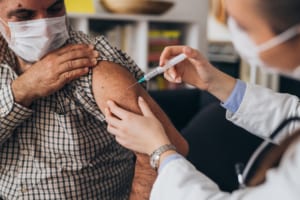Updated September 23, 2021
Reactions to vaccines, in general, are rare with the incidence of anaphylaxis estimated at 1.31 in 1 million doses given. After the FDA emergency use authorization of the Pfizer-BioNTech COVID-19 vaccine on Dec. 11, 2020, and the Moderna vaccine on Dec. 18, 2020, a review of cases by the CDC demonstrated anaphylaxis rates after mRNA vaccines of approximately 5 cases per million doses. The anaphylaxis rate for the adenovirus vector-based Johnson & Johnson COVID-19 vaccine has not been reported but is likely to be closer to the general incidence seen with other vaccines.
The ACAAI COVID-19 Vaccine Task Force provides the following guidance for physicians and other providers related to risk of an allergic reaction on vaccination.
These recommendations are based on best knowledge to date but could change at any time, pending new information and further guidance from the FDA or CDC.
1. All subjects should be screened to determine possible risk of an allergic reaction to the mRNA and adenovirus vector COVID-19 vaccines.
- Do you have a history of an immediate (<4 h) or severe allergic reaction to an injectable medication (intravenous, intramuscular, or subcutaneous)?
- Do you have a history of an immediate (<4 h) or severe allergic reaction to a prior vaccine?
- Do you have a history of an immediate (<4 h) or severe allergic reaction to polyethylene glycol (PEG), a polysorbate or polyoxyl 35 castor oil (e.g., paclitaxel) containing injectable or vaccine?
Modified from Banerji A et al. The Journal of Allergy and Clinical Immunology: In Practice (2021).
If yes to any of these answers, the subject should be referred to a board-certified allergist/immunologist for further evaluation prior to COVID-19 vaccination.
2. The COVID-19 vaccines should be administered in a health care setting where anaphylaxis can be treated. All individuals must be observed for at least 15-30 minutes after injection to monitor for any adverse reaction. All anaphylactic reactions should be managed immediately with epinephrine as the first line treatment. Following treatment of reaction, blood should be collected from the patient to measure serum tryptase (a mast cell marker) within 30-90 minutes. If possible, C3a, C3b, C5a and SC5b-9 (the terminal complement complex as markers of complement activation) should be sent as these may be elevated in anaphylaxis. According to the CDC, the following laboratories can do the above tests: Tryptase – ARUP Laboratories, Labcorp, and Quest Diagnostics; SC5b-9- Quest Diagnostics and Clinical Laboratory Clinic at National Jewish Hospital.
3. The mRNA and adenovirus vector COVID-19 vaccines should not be administered to individuals with a known history of a severe allergic reaction to any component of a particular vaccine. Although the specific vaccine component causing the anaphylaxis has not been identified, polyethylene glycol (PEG) is one of the ingredients in the mRNA vaccines and has been known to cause anaphylaxis. Polysorbate 80 is an ingredient in the adenovirus vector vaccine which may cause anaphylaxis and may theoretically cross-react with PEG.
Patients with allergic reactions to PEG should not be immunized with the mRNA COVID-19 vaccines. Consideration may be given to vaccination with adenovirus vector COVID-19 vaccine. The CDC recommends that the adenovirus vector vaccine should be considered instead of a second dose of an mRNA vaccine for patients who had an allergic reaction to the first dose of an mRNA vaccine.
People who have received one mRNA COVID-19 vaccine dose but for whom the second dose is contraindicated should wait at least 28 days after the mRNA vaccine dose to receive the adenovirus vector COVID-19 vaccine. These patients should have the vaccine in a setting able to treat anaphylaxis and be observed a minimum of 30 minutes after the injection.
In patients with a contraindication to adenovirus vector COVID-19 vaccine (including due to a known polysorbate 80 allergy), there should be consideration of administering the mRNA COVID-19 vaccination. Per CDC guidance, polysorbate allergy is not a contraindication to mRNA COVID-19 vaccination but remains a precaution. However, because of potential cross-reactive hypersensitivity between ingredients in mRNA and adenovirus vector COVID-19 vaccines, consultation with an allergist-immunologist should be considered to help determine if the patient can safely receive vaccination. If the mRNA vaccine is given in a patient with polysorbate 80 anaphylaxis, it should be done in a setting able to treat anaphylaxis and the patient observed a minimum of 30 minutes after the injection.
4. Patients who experience a severe or an immediate allergic reaction of any severity, or who have questions related to risk of an allergic reaction, may be referred to a local board-certified allergist/immunologist to provide more care or advice. The ACAAI does not endorse any skin testing protocol for PEG, polysorbate, the mRNA COVID-19 vaccines, or the adenovirus vector COVID-19 vaccine at this time as the predictive value of these tests is still unknown. However, PEG is the only known testable component of the mRNA COVID-19 vaccine and polysorbate 80 is the only known testable component of the adenovirus vector vaccine for which there are published data showing testing may be able to diagnosis IgE mediated allergy to these excipients.
There are skin testing protocols (see references) that have been published in the medical literature that can be considered specifically for the evaluation of patients with IgE mediated allergy histories with the caveat that a negative skin test result does not rule out allergy (e.g., false negative when using a non-irritating skin testing concentration). While administering incremental doses of COVID-19 vaccine is being used by some as an alternative to skin testing, there are no data on efficacy with dilutions or graded challenges with mRNA vaccines or adenovirus vector vaccines.
5. A recent multicenter study (Krantz et al) showed that among 189 patients, 32 (17%) experienced anaphylaxis after their first dose of mRNA COVID-19 vaccine. A total of 159 patients (84%) went on to receive a second mRNA COVID-19 vaccine dose. All 159 patients, (including 19 individuals who had experienced anaphylaxis following the first dose) tolerated the second mRNA COVID-19 vaccine dose. Thirty-two patients (20%) reported immediate and potentially allergic symptoms associated with the second dose that were self-limited, mild, and/or resolved with antihistamines alone. These data suggest that immediate onset mRNA vaccine reactions may not be classic IgE mediated reactions. Additionally, the study’s findings suggest it is safe for most individuals to receive a second dose of the mRNA COVID-19 vaccine, but they may want to discuss the risks and benefits with an allergist first if they have any allergic symptoms with the first dose of an mRNA COVID-19 vaccine.
6. Data regarding risk in individuals with a history of allergic reactions related to mast cell activation syndrome/idiopathic anaphylaxis are limited but vaccination is likely to be safe if appropriate precautions are followed. A decision to receive a COVID-19 vaccine should be undertaken by patients with their physician or other provider administering the vaccine following a discussion of the benefits and risks associated with the vaccine.
7. People with common allergies to medications, foods, inhalants, insects and latex are no more likely than the general public to have an allergic reaction to the mRNA COVID-19 vaccines. If there is a history of severe allergic reaction, the CDC recommends the longer monitoring period of 30 minutes following COVID-19 vaccination. Those patients should be informed of the benefits of the vaccine versus its risks.
8. The mRNA and adenovirus vector COVID-19 vaccines are not live vaccines and can be administered to immunocompromised patients. Physicians and other providers should inform such immunocompromised patients of the possibility of a diminished immune response to the vaccines. A third dose of the mRNA COVID-19 vaccines is recommended in certain immunocompromised patients by the FDA.
9. For persons with a history of dermal filler use: Infrequently, persons who have received dermal fillers may develop swelling at or near the site of filler injection (usually face or lips) following administration of a dose of an mRNA COVID-19 vaccine. This appears to be temporary and can resolve with medical treatment, including corticosteroid therapy. mRNA and adenovirus vector COVID-19 vaccines may be administered to persons who have received injectable dermal fillers who have no contraindications to vaccination. No additional precautions are needed. However, these persons should be advised to contact their health care provider for evaluation if they develop swelling at or near the site of dermal filler following vaccination.
10. Delayed reactions have been reported with vaccines including the current mRNA COVID vaccines. They can occur hours to days later and include pain, burning, swelling and redness at the injection site. Although likely immune mediated, these reactions are not IgE mediated reactions. Delayed reactions are often self-limited and do not contraindicate administration of future doses of the same vaccine.
References
Matthew S. Krantz, MD; Jason H. Kwah, MD, MSCI; Cosby A. Stone Jr, MD, MPH; et al; Safety Evaluation of the Second Dose of Messenger RNA COVID-19 Vaccines in Patients With Immediate Reactions to the First Dose; JAMA Internal Medicine, July 26, 2021.
Banerji A, Wickner PG, Saff R, Stone CA Jr, Robinson LB, Long AA, Wolfson AR, Williams P, Khan DA, Phillips E, Blumenthal KG, mRNA Vaccines to Prevent COVID-19 Disease and Reported Allergic Reactions: Current Evidence and Suggested Approach, The Journal of Allergy and Clinical Immunology: In Practice (2021)
Stone CA, Liu Y, et al. Immediate Hypersensitivity to Polyethylene Glycols and Polysorbates: More Common Than We Have Recognized. J Allergy Clin Immunol Pract. 2019; 7(5): 1533–1540.
Kaakati R, Khokhar D, Akin C. Safety of COVID-19 vaccination in patients with mastocytosis and monoclonal mast cell activation syndrome. J Allergy Clin Immunol Pract. 2021 Aug;9(8):3198-3199.
Bonadonna P, Brockow K, Niedoszytko M, Elberink HO, Akin C, Nedoszytko B, Butterfield JH, Alvarez-Twose I, Sotlar K, Schwaab J, Jawhar M, Castells M, Sperr WR, Hermine O, Gotlib J, Zanotti R, Reiter A, Broesby-Olsen S, Bindslev-Jensen C, Schwartz LB, Horny HP, Radia D, Triggiani M, Sabato V, Carter MC, Siebenhaar F, Orfao A, Grattan C, Metcalfe DD, Arock M, Gulen T, Hartmann K, Valent P. COVID-19 Vaccination in Mastocytosis: Recommendations of the European Competence Network on Mastocytosis (ECNM) and American Initiative in Mast Cell Diseases (AIM). J Allergy Clin Immunol Pract. 2021 Jun;9(6):2139-2144.
CDC: Information about COVID-19 Vaccines for People with Allergies
CDC: What to Do if You Have an Allergic Reaction After Getting a COVID-19 Vaccine
CDC: Clinical Considerations for COVID-19 Vaccination
CDC: COVID-19 Vaccines for Moderately to Severely Immunocompromised People
McNeil MM, Weintraub ES, Duffy J, et al. Risk of anaphylaxis after vaccination in children and adults. J Allergy Clin Immunol. 2016; 137(3):868-878.
Dreskin et al. International Consensus (ICON): allergic reactions to vaccines. World Allergy Organization Journal 2016; 9:32.
Wylon, K., Dölle, S. & Worm, M. Polyethylene glycol as a cause of anaphylaxis. J Allergy Asthma Clin Immunol. 12, 67 (2016).
Insights from American College of Allergy, Asthma and Immunology COVID-19 Vaccine Task Force: Allergic Reactions to mRNA SARS-COV-2 Vaccines. Annals of Allergy, Asthma & Immunology, January 2021.



